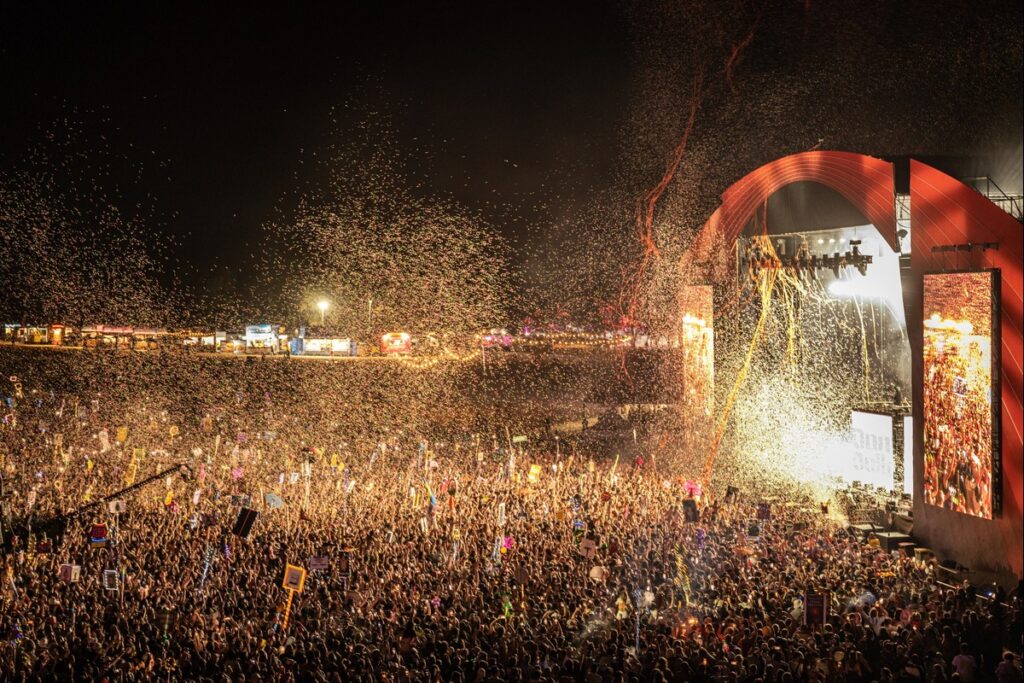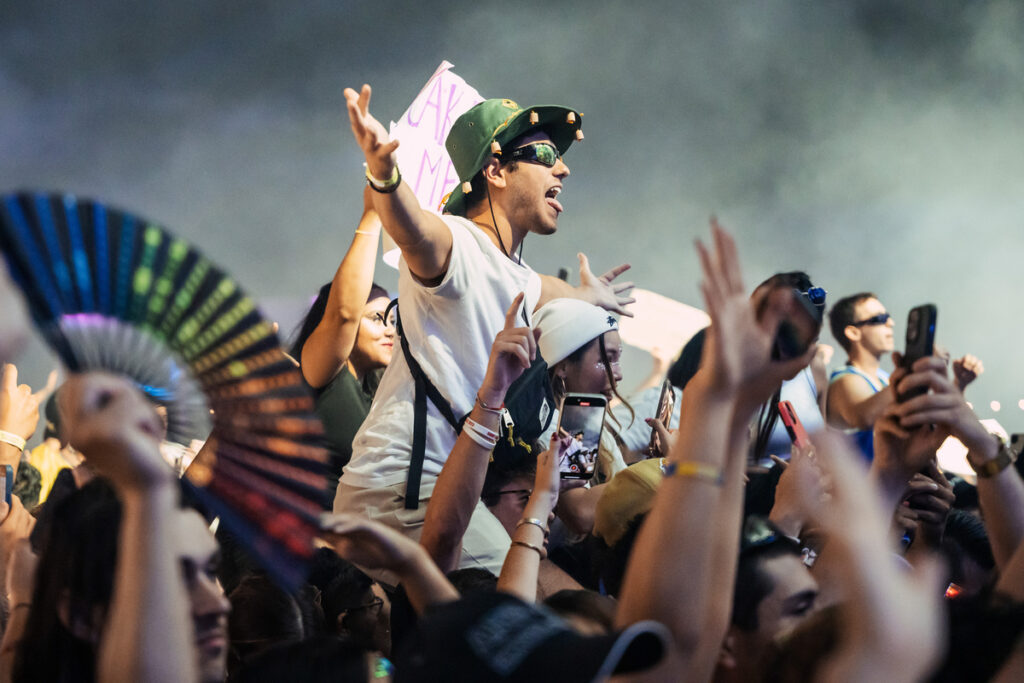The last festival season was a literal and metaphorical wash out. Calendar linchpins went under while others had to be cancelled mid-way through due to inclement weather. Many promoters are clutching on by their fingertips and, in all likelihood, the spate of sinkages will continue.
Yet beneath the carnage lies battered optimism as promoters push on to provide Aussies with their sacred gatherings of music, dance, and celebration. Rolling Stone AU/NZ has spoken with industry heavyweights to get a sense of what the upcoming festival season holds, and what the scene needs to survive.

“We’re Concerned About Australia”
Depending on who you ask, what we’re seeing is either an oversaturated market correcting itself or a sign that governments need to urgently prop up an ailing industry that supports thousands of jobs and millions in economic benefit. The truth, as always, is somewhere in between.
Firstly, Australia has a lot of festivals. 535 festivals — or 1.5 per day — were held between July 2022 and June 2023 according to the Soundcheck report published by Creative Australia in April. The first-ever report into the state of the festival industry was conducted by the federal government’s arts body who are tasked with implementing the $300 million, five-year ‘Revive’ national cultural plan. Overall, the report found that things are decidedly mixed. Just over half of Aussie festivals manage to turn a profit, with an average surplus of around $2.6 million. A little over a third, however, make a loss.
Splendour in the Grass’ shocking collapse exemplifies many of the structural problems all festivals have been increasingly subjected to since the pandemic. With balance sheets still stabilising, inflation in the sector is up 30-40% and promoters can’t pass those costs entirely onto customers without driving them away. Combine that with a weaker Aussie dollar, reduced disposable incomes in the target younger demographics, and cost-cutting purchasing behaviours, and you’ve got a self-perpetuating spiral: Fewer eye-popping lineups and lacklustre sales. The pips are squeaking and the international scene can hear them.
“To come to the arse end of the world, which is Australia, these artists are like, ‘Well, I can just stay in Vegas or in Europe and do two shows in one day and get the same amount [of money],’” Travis Grech, Director of Melbourne-based promoters Finders Keepers told Rolling Stone AU/NZ. The group is behind major events including Good Things, Ministry of Sound, and Ultra.
Love Music?
Get your daily dose of everything happening in Australian/New Zealand music and globally.
“Agents are extremely worried about their artists coming to Australia. ‘Is the festival going to happen and is it going to be a great festival?’ That’s what we’re hearing straight from the big guys: ‘We’re concerned about Australia.’”

Travis Grech
Adapt or Die
Splendour’s post-mortem discourse pointed to the idea that a generalist approach may no longer work in an era of algorithmically-driven and increasingly disjointed music tastes. However, while genre-specific festivals like the Mundi Mundi/Big Red Bash events, Byron Bay Bluesfest, and Woodford Folk Festival aren’t immune, they appear to be surviving through community loyalty. It probably doesn’t hurt that they appeal to an older, wealthier crowd, either. [EDITOR’S NOTE: This feature was written prior to Byron Bay Bluesfest announcing 2025 would be its last year.]
Bill Hauritz AM, who founded Woodford in 1987 and oversaw its operations until stepping down last year, told Rolling Stone, “We don’t see ourselves as a music industry event — although it is. We see ourselves as a community development event.” The six-day New Year’s Eve folk gathering in the Woodfordia utopia of South East Queensland sees 120,000 people descend for what Hauritz describes as an expression of traditional, folkloric idea-sharing.
Having been around for longer than most, Hauritz said that while times may be tough, “every year” is make or break in this game.
“A festival needs to adjust and reorganise itself and look for other ways of making itself relevant,” he said. “We know and have learnt that if we did the festival perfect this year in every way, and did the same festival next year, it would be imperfect in every way.”
Constant adaptation may go some way to explaining Woodford’s longevity. Untitled Group, who are behind Beyond the Valley, Pitch Music & Arts, Wildlands, Grapevine Gathering, For the Love, and Ability Fest, appear to be treading a similarly successful path. While others struggle, Untitled now sell more tickets than they did before the pandemic at their 250 events across the year.

Bill Hauritz AM with former prime minister Bob Hawke.
Pete Sofo, Director of Festivals & Events at Untitled, told Rolling Stone AU/NZ that the secret to the Melbourne-based group’s success lies in its independence and agility but, crucially, in understanding its audience.
“Our marketing team here does an amazing job at really drilling down into the audience data. They go through data like no one I’ve ever seen. It’s really quite incredible to watch,” he said.
With a decade of experience under their belt, Untitled now run their own booking agency, creative agency, and international touring division which is expanding into Asia. But the group came up in the club scene and remain in touch with their roots through ownership of a number of Melbourne venues. This, Sofo explained, is integral in shoring up their international reputation.
“Artists want to come in and they want to build an audience and a fan base here. The way to do that is to partner with someone who understands the culture and understands the market,” Sofo said.
The results speak for themselves. After losing right-of-passage festival experiences during COVID and then being hit the hardest by cost-of-living pressures, 18-24 year olds are no longer the biggest ticket-buyers in the festival space. For Untitled, however, young people remain their biggest market.
Still, the harsh Australian climate presents its own set of challenges.The dramatic cancellation of Pitch in March is perhaps something of a sign of things to come as the climate crisis deepens. Sofo reflects it’s, “something we need to be much more diligent about preparing for.”
“This was the first year that we were really, really tested to this level, and it did expose some things that we do need to change and fix,” he says. “We are pretty confident that we’ve got the right people at the table now to come back to that space.”

Red Tape, Resources and Rorts
As the difficulties pile up, calls have been made for additional funding to ensure the survival of Australian festivals. To that end, the federal government allocated $8.6 million for a new Revive Live programme overseen by Creative Australia. It’s aimed at providing “essential support to live music venues and festivals showcasing Australian bands and artists — to ensure the long-term sustainability of the live music sector,” according to a spokesperson from the Department of Infrastructure, Transport, Regional Development, Communications and the Arts who spoke to Rolling Stone AU/NZ. While specifics are yet to be finalised at the time of writing, the money will go to “support music festivals to continue to operate and create a more sustainable industry.”
$8.6 million sounds like a lot but it’s unlikely to stem the tide given that the average festival in Australia costs $3.9 million to put on.
Greens Senator Sarah Hanson-Young, who headed a Senate inquiry interim report into Australia’s national cultural policy, told Rolling Stone AU/NZ, “we didn’t get what we needed from the Federal Budget.”
“The Senate heard compelling evidence that the Government should step in to mitigate the rapidly rising cost of overheads, like insurance premiums, particularly for those small, medium and local Australian music and arts festivals,” Hanson-Young says. “The arts in Australia are being crunched. While additional funding for Australian festivals and live music was of course welcome, it is clear that local festivals need a real support package at a much bigger scale.”
Hauritz, who notes that government funding accounts for “less than 1.5 per cent” of Woodford’s revenue, believes additional spending may be required as a short-term stabiliser. Money Woodford will likely receive this year “won’t be a huge sum but just might get us over the line.”
However, he is sceptical that government hand-outs are the answer: “The festival graveyard is full of successful funding applications. As soon as that money dries up, those festivals die,” he warns. In addition, he believes funding tends to stifle creative freedom, resulting in “programme mediocrity and risk-free events”.
It’s a fine line between a lifeline and a leash. Electronic music, despite being the most popular festival genre in Australia, struggles to get the kind of support that, say, classical music does.
“With Ultra, the amount of grants that we have applied for where we get told, ‘Sorry, amazing grant proposal, but you don’t fall under certain categories’ — I don’t understand it,” Grech says. “Our grant writer tells us all the time, ‘Trav, it’s because they don’t understand electronic music.’ We spend so much time and effort to deliver these grants to the City of Melbourne and we still don’t get support. Like, what’s the point?”
Finders Keepers also note the difficulty of staging shows in New South Wales, where around a quarter of the nations’ festivals happen, because of the ‘user pays’ requirements for policing introduced under the NSW Music Festivals Act 2019. The act has been blamed for the closure or relocation of a number of festivals, including Return to Rio, after policing and ambulance costs rose by as much as 400%.
“Safety for us is our number one priority,” Grech said. “But, in New South Wales, they see you as the issue. It is not a nice environment to be in, in those meetings. They treat you like you’re criminals. You’re taking 50, 60 police off the street for 15,000 people at a music festival and you’re charging us $160,000. Compare that to Melbourne, which is 20K at the top end, for the same amount of people. How is that justifiable?”
Ultra’s last Sydney show was in 2020 and Grech says, “there’s no appetite to go back with the costs the way they are.” Instead, the group has expanded into Queensland and are in talks for shows in Perth given the WA government’s recent interest in boosting the state’s cultural offerings.
“There is now a big expression of interest in Perth for music festivals to happen, which is great,” Grech says. “I haven’t seen anything like that in Melbourne and definitely haven’t seen a big expression of interest in Sydney.”
For what it’s worth, the Music Festivals Act in NSW has come under review. However, the results are yet to be seen at the time of publication, several months after the Music and Night-time Economy Minister John Graham said they would be released “shortly.”
Grech noted that ‘turnkey’ venues for outdoor festivals — whereby local governments fund temporary infrastructure for multiple festivals to operate in the same space on consecutive days — could be a big help. This is the norm in cities like London where back-to-back day festivals are held.
The Senate interim report also called for government intervention in festival insurance policies which have increased tenfold since Covid. Excesses have also blown out, leaving promoters on the hook for much larger sums in the event of cancellation. This could see fewer events willing to roll the dice on favourable weather conditions.
Sofo describes the current insurance process as “really cumbersome.” “If you’re a small operator, it’s probably nearly impossible, if I’m honest,” he says.
“We want to see governments step in to create a clear and concise insurance program for music festivals and the music industry more broadly,” Sofo adds, noting Untitled made the point in a submission to the Senate inquiry. “I certainly think we need a seat at the table when we’re talking about insurance reform for festivals.”
Rolling Stone AU/NZ put this issue to the Department of Arts and was told by a spokesperson that insurance pricing is a commercial decision which the federal government has little say over. However it “understands the concerns of businesses and is monitoring these issues.”
“Businesses are encouraged to work with their state government and explore, through insurance brokers, whether there are any further actions they could take to lower the risk profile of their business so that they can obtain cover,” a spokesperson said.

It Ain’t Trickling Down
At the bottom of the food chain are the musicians who are arguably the reason we go to festivals in the first place. Andy Golledge is a familiar face around the Sydney music scene and tells Rolling Stone AU/NZ that “a lot of musicians” feel that “it’s impossible to do this right now.”
“For me, at my stage, [festivals are] super important,” Golledge, whose second album Young, Dumb & Wild dropped in April, says. “But I’m noticing that a lot of the typical festivals that I would get… don’t have enough money to pay an artist of my standing because they’re invested in overseas acts and there’s not really that much left behind for Australian artists.”
Studies have shown that home-grown artists are living increasingly precarious lives, with many on the verge of quitting. Golledge notes that, in June when festival bookings for the summer season normally come in, his inbox was empty.
“I’m in this kind of weird limbo where I’m not sure whether that revenue is there for me this year, which is a bit frightening,” he said.
His experience speaks to the fact this industry often runs almost entirely on good will, hard work and passion, which are not endless resources. Artists are having to stretch the limits of their ability to endure and adapt.
“I was around during the lockout laws, which had a pretty bad effect, but I was also living in Newtown, which just became the new Kings Cross. So, there’s always a scene. You just gotta get out there and find it,” Golledge says. “There’s not all darkness and gloom. There is still light. There’s plenty of people making really great music.
“It’s just, we just need to find a way to make it work. I feel like there’s a shift approaching. There’s just too many musicians having a hard time to let things go on like this. I’m still in the position where I can afford to travel around with the band and do the things that I love. And right now, that’s enough.”

Woodford Folk Festival
The Exaggerated Death of the Aussie Festival
Plenty of eulogies were penned for Australian music festivals at the end of the last season. These were perhaps premature. Humans have been coming together in ritual celebration for tens of thousands of years and, if all goes to plan, will continue to do so. The economic impact of a festival alone justifies financial investment but the ‘value’ of meeting the future father of your children, letting off steam in the mosh, or forging life-long memories with friends and family cannot be quantified. At the extreme end of lyrical waxing, festivals are an expression of humanity. It’s what we do best as a species. But we’re not out of the woods yet. A degree of soul-searching is required.
“There are so many different models of festivals. And I think there’s some that are just outdated and that don’t mean anything anymore,” Hauritz says. “The marketplace works if you want to put on a festival and make some money. There’s nothing wrong with wanting to make money. I congratulate people who make profits. But I think the culture that underpins it is critical to the success of the event beyond the commerciality of it, for it to make a positive cultural impact.”
Hauritz recounts his post-festival ritual after the punters have left and the staging has been packed up. He drives to Mooloolaba, “the best beach in the world, in my opinion”, and swims out into the ocean to reflect.
“I just float there and get sunburned and watch the fish swim around and I wonder, ‘Was it worth it? What impact did it make? Is the world a little bit better off or a little bit worse off for having had the festival?’ I reckon that’s a good question to ask, that every festival should ask.”
When asked for his own answer, Hauritz speaks at length about the environmental cost of celebration that the festival has worked hard to negate, as well as the ongoing horrors across the globe and the disconnection of the digital age.
“I think it’s a better world,” he says at last. “Not by a lot. Not by a lot. But I think we’re on the right side of the ledger.”
This article features in the September-November 2024 issue of Rolling Stone AU/NZ. If you’re eager to get your hands on it, then now is the time to sign up for a subscription.
Whether you’re a fan of music, you’re a supporter of the local music scene, or you enjoy the thrill of print and long form journalism, then Rolling Stone AU/NZ is exactly what you need. Click the link below for more information regarding a magazine subscription.



































